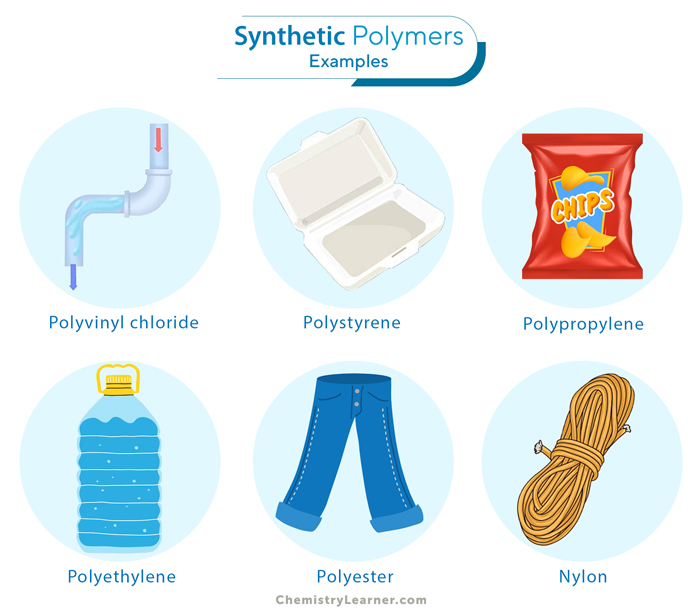Synthetic Polymers
Synthetic polymers are large molecules made by linking together smaller units called monomers. These monomers join in a process called polymerization, creating long chains that make up the polymer. Synthetic polymers are created through chemical reactions and are used to make many everyday materials like plastics, fibers, and rubber. [1-4]
Properties of Synthetic Polymers [1-4]
- Durability: Synthetic polymers are often very strong and resistant to wear and tear, making them ideal for long-lasting products.
- Flexibility: Many synthetic polymers can be flexible, meaning they can bend without breaking. This property is useful in products like plastic bags and rubber bands.
- Lightweight: Synthetic polymers are generally lighter than materials like metal or glass, making them easy to carry and transport.
- Chemical Resistance: Synthetic polymers are often resistant to chemicals, which means they don’t easily react with substances like acids, bases, or solvents.
- Water Resistance: Many synthetic polymers do not absorb water, which makes them useful in waterproof products like raincoats and containers.
- Thermal Insulation: Some synthetic polymers can act as good insulators, meaning they don’t easily conduct heat. This property is important in materials like foam insulation and plastic containers.
- Electrical Insulation: Synthetic polymers often do not conduct electricity, making them ideal for use in electrical wiring and devices.
- Versatility: Synthetic polymers can be manufactured in various forms—solid, liquid, or flexible—depending on their application, ranging from fibers to films to molded shapes.
- Cost-Effective: Producing synthetic polymers is often cheaper than using natural materials, which makes them a cost-effective option for mass production.
- Colorability: Synthetic polymers can be easily dyed or colored during manufacturing, allowing for a wide range of colors and finishes in products.
Types of Synthetic Polymers
Synthetic polymers are broadly classified into two main types: thermoplastic and thermoset. [1-4]
Thermoplastic Polymers
Thermoplastic polymers are a type of synthetic polymer that becomes soft and moldable when heated and hardens upon cooling. This process can be repeated multiple times, allowing the material to be reshaped and recycled. The ability to soften with heat and solidify when cooled makes thermoplastics versatile and widely used in various applications.
Examples
- Polyethylene (PE) is one of the most widely used synthetic polymers. Due to its outstanding strength and flexibility, PE is commonly found in plastic bags, bottles, containers, water pipes, insulation materials, and artificial joints.
- Polypropylene (PP) is another versatile synthetic polymer known for its high resistance to heat and chemicals and for its durability. It finds extensive use in automotive parts, packaging materials, furniture, carpets, upholstery fabrics, and geotextiles.
- Polyvinyl chloride (PVC) is a widely used synthetic polymer known for its excellent corrosion resistance. PVC pipes are commonly used for plumbing systems. PVC is also found in electrical cables, window frames, flooring materials, and even medical devices such as IV bags.
- Polystyrene (PS) is a lightweight synthetic polymer that can easily be molded into various shapes. It is commonly used for packaging materials like foam trays and disposable cups. PS can also be found in insulation panels for buildings or as a component in consumer electronics.
- Nylon is a synthetic polymer that revolutionized the textile industry with its strength and durability. Due to its high tensile strength, nylon is widely used in producing clothing items such as stockings, swimwear, sportswear, and even parachutes.
Thermoset Polymers
Thermoset polymers are a type of synthetic polymer that, once formed, cannot be melted or reshaped. They are created through a chemical process called curing, where the polymer chains cross-link to form a rigid, three-dimensional structure. This cross-linking makes thermoset polymers very strong and heat-resistant, but it also means that once they are set into a shape, they cannot be remolded or recycled by heating. These properties make thermoset polymers ideal for applications where durability and heat resistance are essential.
Examples
- Epoxy Resin is known for its strong adhesive properties and chemical resistance. It is used in adhesives, coatings, and composite materials.
- Phenolic Resin is heat-resistant and known for its flame-retardant properties. It is used in electrical insulations and as a binder in composites.
- Melamine Formaldehyde is hard, durable, and heat-resistant. It is used in kitchenware and countertop laminates.
- Silicone is flexible, heat-resistant, and has excellent sealing properties. It is used in sealants, medical devices, and cookware.
- Bakelite is one of the first synthetic thermosetting plastics ever produced and is known for its rigidity and heat resistance. It is used in electrical insulators and early plastic consumer products.
Natural Polymers vs. Synthetic Polymers
Natural polymers are derived from natural sources, including plants, animals, and microorganisms. In contrast, synthetic polymers are manufactured through chemical processes. To better understand the characteristics of natural and synthetic polymers, let us examine the following table: [1-4]
| Property | Natural Polymers | Synthetic Polymers |
|---|---|---|
| Source | Derived from plants and animals | Manufactured or derived from petrochemicals |
| Structure | Often complex, irregular | Often more uniform and regular |
| Biodegradability | Often biodegradable | Varies, some are non-biodegradable |
| Strength | Variable, depending on the source | Can be engineered for specific strengths |
| Cost | They can be expensive due to extraction and processing | Generally less expensive due to manufacturing processes |
| Examples | Cellulose, proteins, natural rubber | Polyethylene, PVC, epoxy |
FAQs
Ans. The three ways synthetic polymers affect the environment are:
1. Plastic pollution in oceans and landfills
2. Non-biodegradable nature of synthetic polymers
3. Microplastics contamination in water bodies and food chains
Ans. Belgian chemist Leo Baekeland created the first synthetic polymer, Bakelite, in 1907.
Ans. Cellulose is a natural polymer.
Ans. Kevlar is a synthetic polymer.





